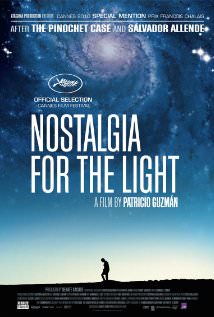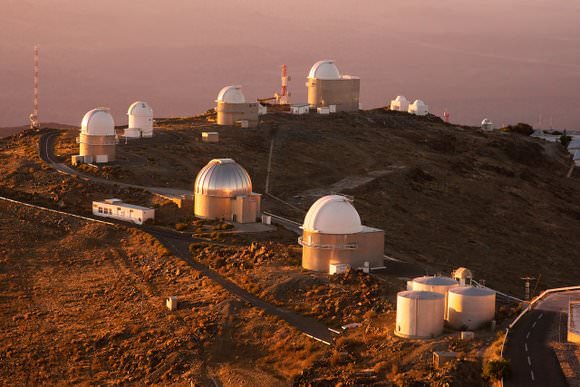[/caption]
 It’s difficult enough to imagine stark white telescope domes towering over a parched brown landscape made even more arid by the near-constant whistle of high-altitude winds. It’s stranger still to consider that in the desert below those domes, tough and grieving women have been searching in vain for decades for the sun-bleached remains of loved ones stolen from them, killed and dumped in the void by Pinochet’s army.
It’s difficult enough to imagine stark white telescope domes towering over a parched brown landscape made even more arid by the near-constant whistle of high-altitude winds. It’s stranger still to consider that in the desert below those domes, tough and grieving women have been searching in vain for decades for the sun-bleached remains of loved ones stolen from them, killed and dumped in the void by Pinochet’s army.
Acclaimed Chilean film director Patricio Guzmán has woven these stories together into a documentary called Nostalgia de la Luz, or Nostalgia for the Light, that is both touching and stunning, human and other-worldly, emotional — and hopeful.
The film played at the Toronto International Film Festival and at Cannes before lighting up a packed theater at 10 a.m. on a Sunday morning in Boulder, Colorado, a community with a special fondness for space science owing partly to the presence of the Laboratory for Atmospheric and Space Physics, Ball Aerospace, NOAA’s Space Weather Prediction Center and the Southwest Research Institute.
In fact Jason Glenn, an astronomer at the University of Colorado at Boulder, took the podium for a few moments before the start of the film to announce plans for the Cornell-Caltech-Atacama (CCAT) telescope proposed to go atop the Chilean mountain Cerro Chajnantor — and to request donations toward its construction. CCAT, a submillimeter telescope, will be used to probe primeval galaxies, star formation and extra-solar planetary systems.
The film opens with awe-inspiring images of galaxies, close-up views of the pockmarked lunar surface, and eerily beautiful shots of the vast Atacama. The desert lies west of the Andes Mountains in Chile, and is generally regarded as the driest place on Earth. That, plus its high altitude, make it a perfect place for astronomy. The Atacama supports the ESO’s Atacama Large Millimeter/submillimeter Array (ALMA), the Very Large Telescope (VLT) and numerous other instruments. Many Chileans, the film intimates, grow up loving astronomy.
Meanwhile the people of Chile continue to heal from Pinochet’s bloody rule beginning in the early 1970s, when thousands of his political opponents were taken from their families and disappeared. The film captures the perspectives of people on all sides of the tragedy — from the grieving mothers and wives, the archeologists working to decipher both the recent and distant human past, survivors of Pinochet’s concentration camps and even astronomers who, tucked in offices underneath the massive telescope domes, might not seem to have much in common with the grieving women. But they do.
Gaspar Galaz, an astronomer at the Pontifical Catholic University of Chile, says in the film that both he and the women pursue quests to learn history; they’re all chasing rare clues in dauntingly vast spaces. Galaz peers far across the cosmos to study diffuse galaxies, whose origins are unknown, and the women comb the 40,600 square mile (105,000 km2) desert for minute fragments of bone. The difference: At the end of his workday, Galaz says, he can get a good night’s sleep, “but these women must have trouble sleeping after they search for human remains.”
Nostalgia de la Luz is worth seeing for any of its parts — the glimpses through the powerful Atacama telescopes, the desert scenes, the cultural insights or the beautifully human and optimistic ending, which I won’t give away here. Taken together, the film’s elements are an experience not to be missed.
Several trailers for Nostalgia de la Luz are available on YouTube; upcoming showtimes include, according to Facebook, March 8 and 9 at the Wexner Center for the Arts in Columbus, Ohio, March 18 at the IFC Film Center in New York and April 22-28 at Landmark’s Nuart Theater in LA. Today’s showing was at the Boulder International Film Festival.


VLA at Atacama?
oops VLT (corrected). Thanks!
Looks great – I’ll check it out for sure.
When I saw the picture of La Silla, I immediately thought that this may be a brilliant documentary about the sadness of that place, with most of the telescopes abandoned. The title was fitting, even.
But no, this is another damn reminder of the typical chilean way, of never forgetting, of never moving on. Damn it!
“But no, this is another damn reminder of the typical chilean way, of never forgetting, of never moving on. Damn it!”
1) I would suggest that simply ‘forgetting’ about the murder of loved ones under a despotic dictator is probably a hard thing to do, and
2) that same is significantly sadder and more worthy subject matter for a doco than the abandonment of superseded telescopes due to budgetary constraints.
But that’s just me.
Me too.
Hope I get to see this film on my side of the Atlantic. =)
Forget? Move on? NEVER! Never forget that my country, the U.S.A., this so-called beacon of freedom and liberty had the elected president of Chile murdered to install this ruthless dictator on the name of business and the Almighty Dollar.
Let justice be done. And let these lessons be learned.
Would you want to forget Galileo? Newton?
Forgetting is NOT how we learn.
… and its copper. God bless the CIA!
I have always loved the desert. Here in southern Ontario, I share the same Great Lakes climate with over 10 million other folks from both sides of the border. This means winters with lots of snow and summers that are humid and contain lots of smog. Oh yes, and lots of high pressure Sodium sky glow at night.
I would relish the opportunity to spend a couple of nights on the Atacama plateau with a pair of binoculors and a light weight tripod. The wide field views of the southern Milky Way must be breathtaking.
My boss is from Chile and he has trekked it. I remember him saying that even though he studied a star chart before hand, under the moonless sky he had a hard time recognizing the major constellations because there were just so many stars visible.
I had the opportunity to stay in Namibia for a few weeks last year (at the HESS telescope to be precise), and, yes, it’s unbelievable how many more stars you can see. Orion seemed to be filled with countless stars. Just amazing!
Yep – and given my life-long obsession and association with astronomy, I’m always surprised at the fact that I’m SURPRISED at the fact that there are so many stars visible at a good dark-sky location.
In a good way of course.